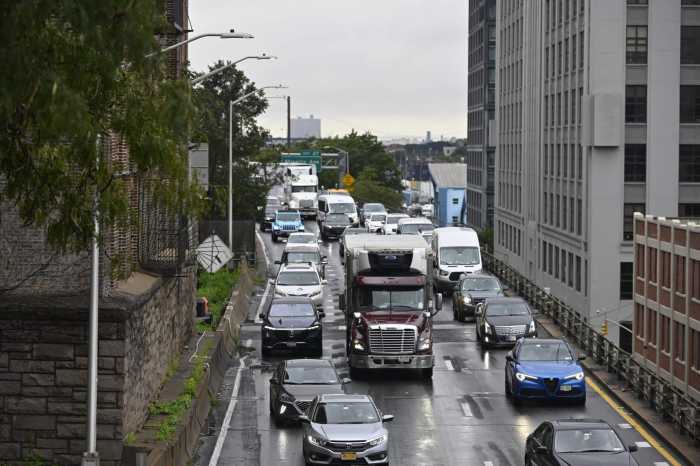New York City will finally start enforcing weight limits for vehicles on the crumbling Brooklyn-Queens Expressway next week, doling out hefty fines to the owners of overweight trucks.
Starting Monday, Nov. 13, the city’s Department of Transportation (DOT) will begin issuing $650 fines to the owners of trucks traveling northbound on the BQE weighing more than 80,000 pounds. Trucks are weighed on the move using automated sensor technology synced with license plate readers, called “weigh-in-motion” (WIM), which has never before been deployed on an American highway.
The sensors are only deployed on the city-owned section of the BQE between Atlantic Avenue and Sands Street in Brooklyn, which includes the “triple cantilever” through Brooklyn Heights. The rest of the highway in Brooklyn and Queens is owned by the state.
Overweight trucks on the northbound BQE have been getting warnings since the sensors were installed three months ago, but now will start receiving fines. Enforcement has not begun in the southbound direction, but DOT says it will start in the coming months after another a three-month period of warnings.

The warnings appear to have made a difference, DOT contends. For instance, in the first week of warnings in August, 344 overweight truck drivers were automatically sent warnings, but that number declined to just 153 by the end of October.
“Overweight trucks cause wear and tear that requires costly maintenance and reduces the lifespan of our roads and bridges,” said DOT Commissioner Ydanis Rodriguez. “We’ve seen a sharp decline in overweight vehicles since we began issuing warnings in August and we expect that the program will continue to remove overweight trucks from our streets.”
The news comes as the Adams administration tries to figure out how to redesign the city-owned section of the highway, and in the meantime forestall it from collapsing. The cantilever was envisioned and constructed by “master builder” Robert Moses in the 1940s, who controversially plowed the highway through a number of existing communities and displaced scores of New Yorkers.
The crumbling cantilever is now approaching the end of its useful life: in 2020, a city-convened “expert panel” warned the cantilever could be unsafe for travel as soon as 2026. The worrying timeline has only been made more frightening by the preponderance of stocky lorries on the highway: the panel estimated about 11% of trucks traveling the highway are overweight, with some clocking in as much as 170,000 pounds.

Despite that, installation of WIM faced considerable delay as the tech needed approval of federal regulators, who sought assurance that the sensors were properly calibrated and would not issue fines to people who did not earn them. That nonetheless earned the ire of local politicos and civic groups who wanted the tech in place quickly. The use of WIM was first approved in late 2021 by Gov. Kathy Hochul and the state legislature.
The administration has put forward a number of proposals for partially or fully replacing the cantilever and covering it up with parkland, connecting Brooklyn Heights with the East River waterfront from which it has long been cut off. But the plans have faced some pushback from local electeds and residents for returning the span to three lanes in both directions, though one of those wouldn’t necessarily be a traditional car lane.
Since the BQE carries Interstate 278, changes to the highway require approval from federal regulators. DOT is also depending on the feds for project financing under the bipartisan infrastructure law. While DOT wanted to start environmental reviews for the project this year, it is instead currently conducting a traffic study regarding the number of lanes in each direction.
Environmental review is not expected to start until next year, and construction is not expected to begin until 2027. In the interim, officials insist the cantilever remains safe and not in immediate danger of collapse.
The state has not indicated intentions to redesign its segments of the highway, despite calls from some local elected officials and residents.
Last month, DOT closed the cantilever to northbound traffic and reduced southbound traffic to one lane for two days to conduct repairs to the decaying structure. The agency said the work consisted of “critical repairs” to extend the highway’s lifespan.
Read more: MTA Plans Next Phase of Subway Signal System Upgrades







































